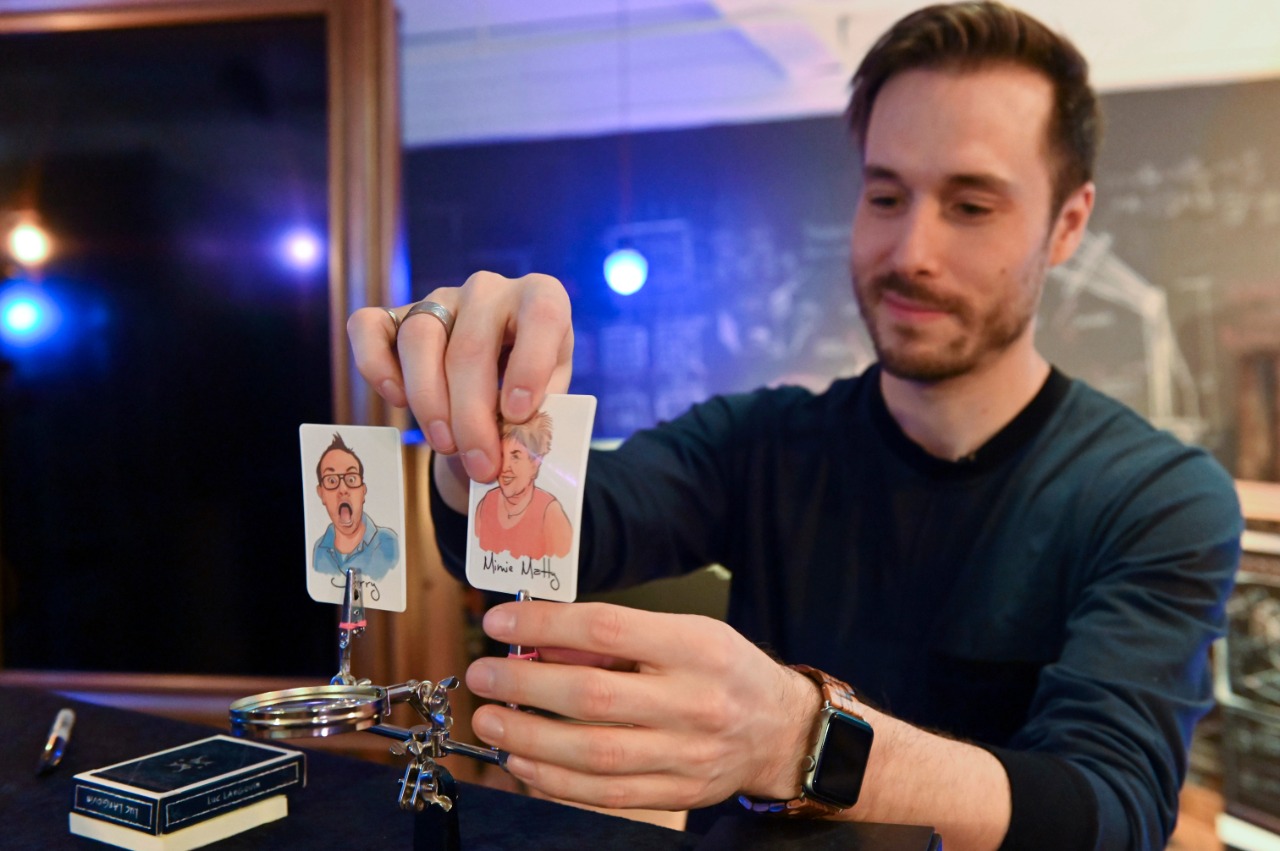Illusionist finds ‘new way to do magic’

Canadian illusionist Luc Langevin sets up a card trick at his Montreal studio with a deck featuring images of French celebrities on January 25, 2021, during rehearsals for a new live streamed magic show. Prevented from touring by pandemic restrictions, Langevin was forced to rethink how to do magic, and from a small studio in Montreal has found success performing in interactive virtual shows. “The pandemic forced me to find a new way to do magic,” says the 37-year-old Canadian. Langevin used to regularly travel to Europe with a team and a lot of equipment for shows, including in France where television appearances helped make him famous. The pandemic and the cancellations of live shows due to travel and public health restrictions forced him to rethink his work, he told AFP. Eric THOMAS / AFP
MONTREAL—Faced with the shutdown of his touring shows due to pandemic restrictions, illusionist Luc Langevin reached far up his sleeve and developed a new trick—interactive virtual performances.
“The pandemic forced me to find a new way to do magic,” said the 37-year-old Canadian.
Langevin, who gives performances in French, used to travel regularly to Europe with a team and piles of equipment for shows, including in France where television appearances helped make him famous.
The pandemic and resulting cancellations of live shows forced him to rethink things, he told Agence France-Presse (AFP).
Going ‘interactive’
Like the martial arts he learned as a child, Langevin “used his adversary’s strengths against him.”
Article continues after this advertisement“The pandemic forces us all to be in front of screens, so I thought to myself: how can I amaze people in this context? “ he said.
Article continues after this advertisementFrom a small studio in Montreal, he has found success with virtual shows.
His large travel trunks are now stacked against a back wall of the studio in a former factory. On a magician’s table sit various items for his tricks—a deck of cards, a lemon, a nut, and a knife.
A camera follows Langevin around the room for just over an hour for his show “Interconnected.”
“All of the acts are very interactive,” he said.
About 20 spectators with “premium” tickets appeared on the edges of the screen. Langevin called out to them, asked them to name an object or a card that he then revealed. He used a magic scarf to turn Donald Trump into a cucumber.
During the show, audience members received an email which he implored them “not to open right away.” It contained information to be offered by audience members that he had already “guessed.”
Some may be disappointed: There were no amazing levitations, poetic storylines or soaring music like in Cirque du Soleil (with which he has collaborated), and sometimes a few glitches—“Eric, your microphone is not plugged in,” he told an audience member.
“Great show, too bad some tricks fell flat,” commented Mikael Turpin in one of the few bad reviews of the show on social networks.
Strong demand
The idea for the new show was to be “close to the people” with a virtual audience that participates and influences the show, giving it an air of originality, according to Langevin.
“I was wondering, would people be prepared to pay $25 or $55 for a one-hour online magic show, with all of the cheap entertainment available on Netflix, YouTube and social networks?” said the artist.
The answer is yes, he added.
The show launched at the end of 2020 and was initially to run for two months. But it has been a hit, selling out the first 40 shows, and demand for upcoming performances continues to be strong.
With only two paid technicians and an average of 850 spectators per show, “we became profitable much faster than we thought,” Langevin said. “All the shows are done here, there’s no big tour buses, no hotel rooms, no per diems to pay my entourage.”
And it’s helped to expand the illusionist’s reach.
“I can do a presentation for Europe at 2:30 p.m.—but over there it’s 8:30 p.m. After that I can go back to my house to eat a meal with my family and come back in the evening for a Canadian show,” commented the married father of a young boy.
Next up: an English-language version of the show for the United States and Canada.
When pandemic restrictions are eventually lifted, Langevin said he may continue performing virtually, interspersed with live in-person shows.
“It’s magic that is very different. The two products can coexist,” he said with a smile. —AFP